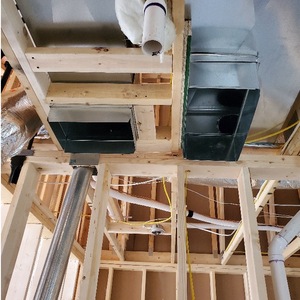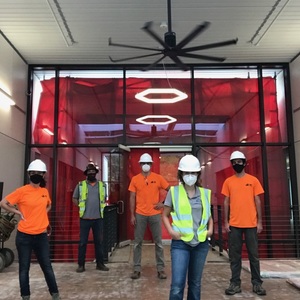
Code-compliant blower door testing of a small home can be frustrating for both the person performing the test and the homeowner or contractor required to have it done. A few months ago, I tested a newly built 952-sq.-ft. home with a volume of 7616 cu. ft.—one of the smallest I’ve ever tested. The house had a leakage rate of 416 cu. ft. per min. (CFM), which resulted in a test score of 3.28 ACH50. That’s a failed test in my climate; code requires 3 ACH50 or less. If we take that same CFM rate and increase the ceiling height to 9 ft., it increases the volume to 8568 cu. ft., which would yield 2.91 ACH50.
Either way, 416 CFM of air moving through the blower door isn’t much. Some kitchen exhaust hoods can move more air than that. It seems unfair to ding smaller houses like this, especially when the blower door test measures only the surface of a structure, not its volume.
Code for small homes
The 2021 IRC makes an exception for blower door testing of small homes. Code N1102.4.1.2 (R402.4.1.2) states:
When testing individual dwelling units, an air leakage rate not exceeding 0.30 cubic feet per minute per square foot [0.008 m³/(s x m²)] of the dwelling unit enclosure area, tested in accordance with ANSI/RESNET/ICC 380, ASTM E779, or ASTM E1827 and reported at a pressure of 0.2 inches water gauge (50 Pa), shall be permitted in all climate zones for:
- Attached single and multiple family building dwelling units.
- Building or dwellings that are 1500 square feet (139.4 m²) or smaller.
Mechanical ventilation shall be provided in accordance with section M1505 of this code or section 403.3.2 of the International Mechanical Code, as applicable, or with other approved means of ventilation.
Basically, this means if a home is 1500 sq. ft. or less, you are able…
Weekly Newsletter
Get building science and energy efficiency advice, plus special offers, in your inbox.

This article is only available to GBA Prime Members
Sign up for a free trial and get instant access to this article as well as GBA’s complete library of premium articles and construction details.
Start Free TrialAlready a member? Log in















2 Comments
Great article Randy, we have been trying to recalibrate to CFM50 for a while now because as you say, air is leaking through the envelope area so that's what we should test against.
It's worth saying the opposite is true for large buildings - CFM50 eliminates their "unfair" ACH50 advantage for larger volumes.
Glad to see this pointed out, been dealing with this issue for years. It's not that I don't want to see houses built tight, it just that ACH50 creates some really uneven application that difficult to justify to builders and inspector sometimes.
We've come to call an effect of this "The Crawlspace Penalty" or more recently "The Slab Penalty". At least that how the builders see it, it could also be called the "Basement Bonus". Basically a big concrete tub under a house is easy relatively air tight volume. Builders that hit around 2 ACH50 with basements (common around here) will suddenly find they are over 4 with a slab using the same building techniques. All the leakage is above grade, but then again the leakage above grade is what matters most anyway.
Now do Total Duct Leakage! Basing it on SF makes no sense. I've been in code minimum McMansions that were leaking half the capacity of the system (600cfm) and passed. Then I'm in a Habitat house that's the most efficient thing I ever get to work with and we're fighting to get it from 95 to 85. A quantity I know will have exactly zero effect on the performance of the home. Again, I want to see tight ducts, and we're getting better all the time, but the limits come across as incredibly uneven. Actually, I would go as far as to say unfair.
Sorry for the tangent here, but it should be said that Total Leakage is generally an over shot of real performance and this matters a lot for smaller systems. Take that same small Habitat system and measure air flow at the AH and then at the registers with a powered flow hood and you have trouble finding that 85 cfm of leakage. The delivered performance looks almost perfect. The point here is that in small homes we're spending too much time fussing with something that's not really having any effect. *end of rant*
Log in or become a member to post a comment.
Sign up Log in